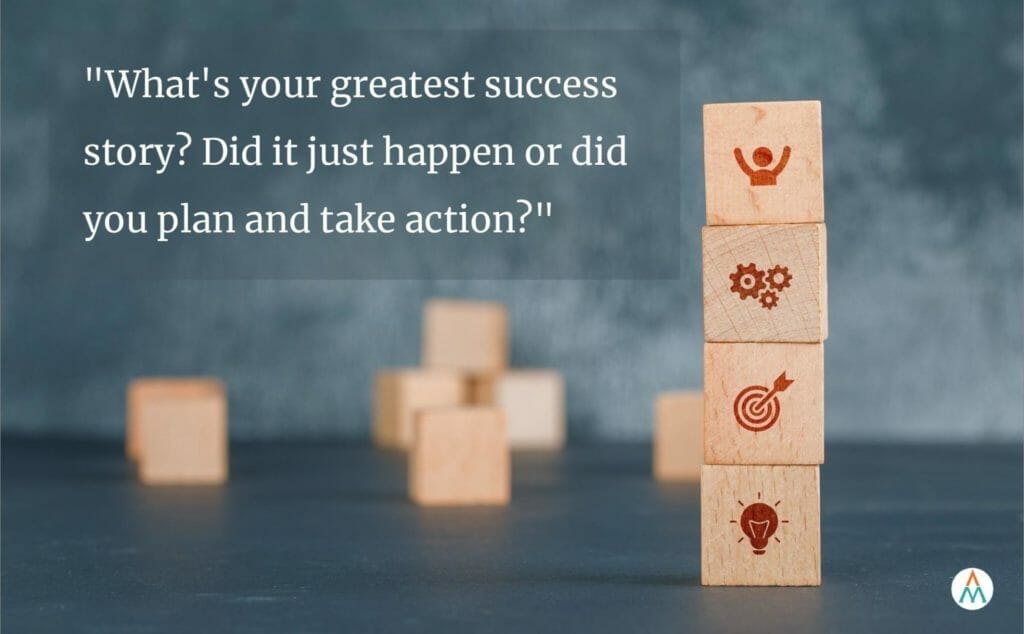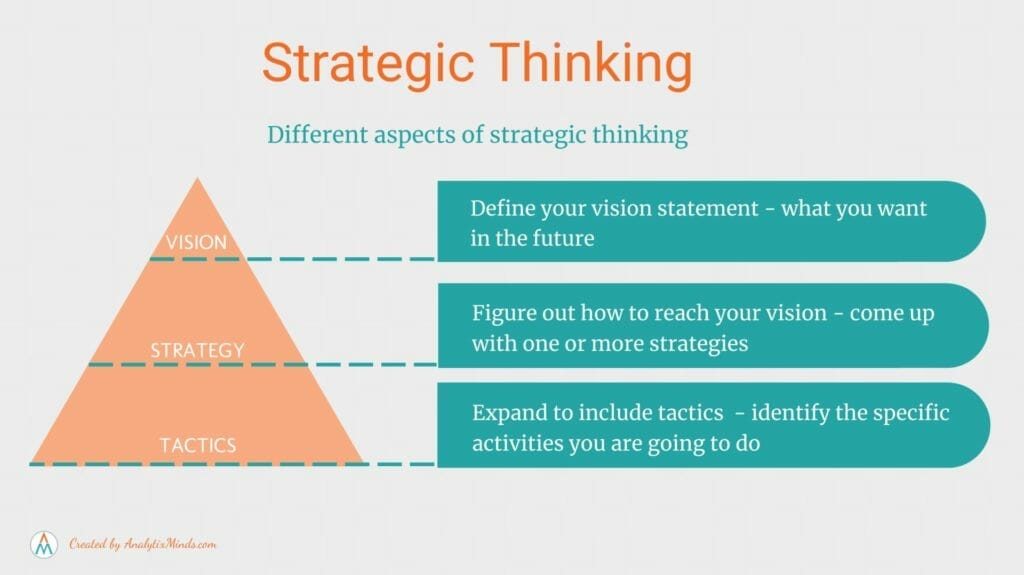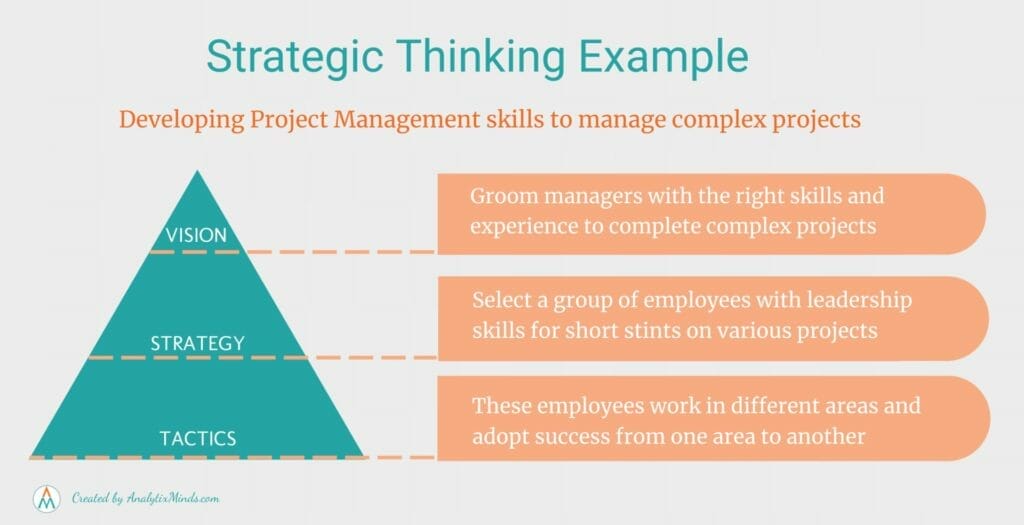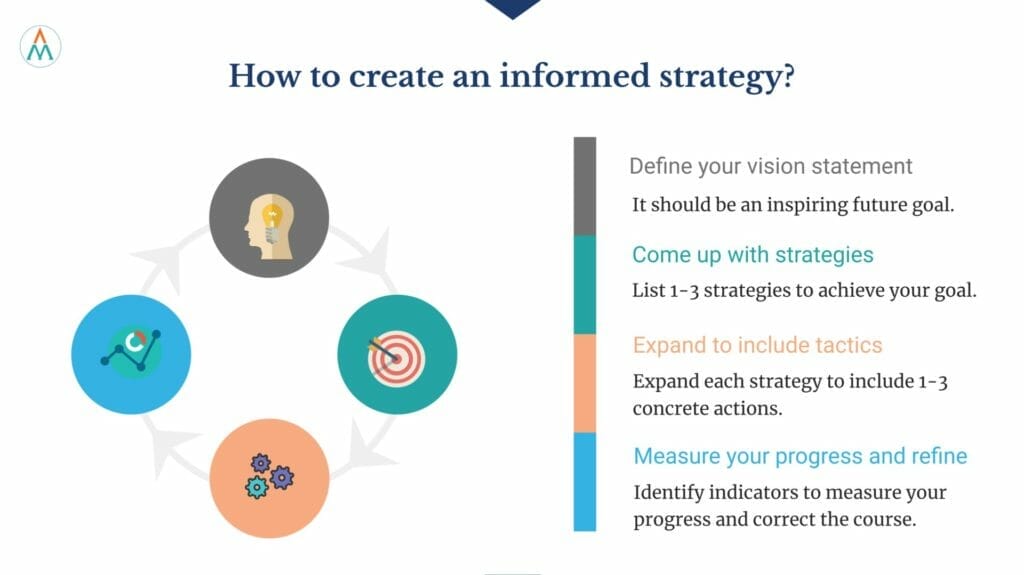Not in the mood to read? Listen to the podcast episode here, or watch the summary video below.
It’s difficult to find a space in life where the word strategy isn’t used. The term is trendy in business circles. Suppose you start paying attention to some of the statements around the word “strategy” in your organization or the media. In that case, you will realize that it seems to mean different things to different people.
You can also find many definitions of “strategic thinking” on Google. It is hard to understand how these different concepts relate to us. Maybe that vagueness also contributes to the perception that it is a difficult skill to master.
Tactics is knowing what to do when there is something to do. Strategy is knowing what to do when there is nothing to do.
The term covers topics from military history to college football to corporate finances and human resource practices. Being able to think strategically is one of the most important leadership traits. The leadership world has a few strategic leadership styles. However, this trait is also highly useful in everyday life.
Watch this video for a quick summary before you keep reading.
Strategy is a long-standing practice. We’ve been using the principles from ancient times for a long time. The Greek word strategy comes from “Stratos” (army or resource) and “ago” (to lead), so the definition is quite literal. In today’s business context, it is described in terms of goals. A strategy explains how an organization will achieve its goals and objectives.
So, what is strategic thinking? What does it look like in everyday life? Can we really learn it?
What is strategic thinking?
In general, the term has been interchangeably used with any concept related to Strategy, vision, goals, and planning. Though we can’t put our finger on it, strategic thinking sounds more like using intuition in a methodical way rather than going with your gut.
Lack of a proper definition shouldn’t stop you from cultivating this crucial skill in your own life. After all, it’s a good trait to have. In fact, as you advance in your career, it becomes more and more important. Most of us don’t even realize we need to learn it ourselves since it’s not taught as a valuable life skill at any point in our lives.
Well, does that mean we can’t think strategically just because we never took a strategic-thinking course at school? In fact, quite the contrary. We’re all born with some innate ability to think and act strategically.

Can you think of a story of amazing success in your life?
Did it happen by chance, or did you plan and take action to achieve success? How did you handle the many challenges you encountered along the way? The chances are you had a strategy to achieve this goal in your life.
Expert strategic thinkers often credit their success to deliberate practice and life experiences rather than their innate ability. If that’s the case, it won’t hurt to find out what they’re doing differently, so pick up a trick or two to try in our own lives.
Let’s pause for a second. How do you know if you are not also an expert strategic thinker? Is it really necessary to improve your strategic thinking skills?
Here are some simple questions to find out if you need any improvements.
- Do you feel you’re good at achieving the goals you set for yourself on a daily as well as a long-term basis?
- Do you sometimes feel the efforts you put in outweigh the results?
- Are your plans and actions bringing you closer to the things that matter the most?
In my case, I opted for ‘sometimes,’ ‘it depends’ or ‘mostly’ for each question. If you also didn’t answer ‘yes’ to all three, you might have an opportunity to reflect and sharpen your critical thinking.
The questions aren’t meant to test our strategic thinking skills but to help us rethink, reflect, and realize there’s always room for improvement.
What is your next strategic goal in your life? How far are you from your goal?
Definition of Strategic Thinking
Let’s simplify the strategic thinking definition since it’s still under development. Strategy is about the big-picture choices that have a broad and long-term impact.
Strategic thinking is basically the practice of selecting a long-term goal and formulating an action plan toward reaching that goal. This forces you to think and plan several moves ahead than you would normally.
It includes goals, objectives, planning, resources, and more. It can’t be reduced to just any one of them.
Suppose you decide to become a cloud engineer or cloud architect because cloud computing is one of the most sought-after hard skills at the moment. In that case, you are thinking strategically about which career path to follow in the next few years.
You think strategically when you pick a long-term goal and plan how to get there. That forces you to think ahead more than you normally would.
Vision, Strategy, and Tactics
These are all different aspects of successful strategic planning. They work together to help you reach your goals. Let’s look at a few strategic mindset examples.

Vision
A vision is the higher goal that you aim for personally or professionally. It’s your way of telling yourself what you want in the future.
A vision statement reflects the organization’s long-term goals, aspirations, and overall purpose in a few sentences. Here are a few examples of vision statements:
“We will be the best construction company in North America.”
“We will create an employee-centric culture.”
“We want to build a company that is sustainable for generations.”
Strategy
It is how you’ll figure out how to reach your vision. For example, a company’s Strategy includes topics such as where it wants to go, how to interact with customers, and how to revise its current trajectory if needed.
It can be a general guiding principle or a well-organized plan. It is always created within the context of your vision. Remember that the purpose of the Strategy is to help you reach your vision.
Some examples of strategies include:
“We want to become the most efficient organization in our manufacturing sector.”
“We want to use technology to transform the way we work.”
“We want our employees to put customers first.”
Tactics
Tactics are the steps you take to reach a goal. They’re more specific than vision, and they’re what will get you from point A to point B. The tactics should have an end and a beginning. They shouldn’t be ongoing projects or initiatives without a defined end.
Keep in mind that tactics are designed around your overall Strategy, which leads you toward your vision. Therefore, tactics shouldn’t be left to chance but instead thoughtfully planned and executed. This is where you lay out all your steps and timelines to reach your goal.
Acquisition of strategically important subcontractor companies is one example of a tactic employed to accomplish the company’s vision of being the best construction company in North America, one of the vision examples earlier.
How vision, Strategy, and tactics are related?
Let’s look at an example in real life.
Vision: A businessman wanted to create an organization that would help people begin new businesses. This organization would help them find funding and develop their business models.
Strategy: He designed a program to assist people at different stages of their business planning. The program helps people build or complete existing business plans. Then provide them with resources to begin implementing those plans.
Tactics: He would conduct a pilot program to test this Strategy. The goal was to get feedback from participants to improve and move forward with a more comprehensive program.
Here is another example;
Vision: A company wanted to groom managers who had the right skills and experience to complete unique projects the company is known for.
Strategy: The company allowed a selected group of employees to work on various projects so they can gain experience.
Tactics: They’d give a bunch of different projects to the employees throughout the year so they would have the chance to work in different areas. Then they are encouraged to adopt success from one area to another and evaluate its impact.

Yeah, you may say that makes sense in a business context, but can I apply strategic skills to my everyday life? Yes, we can, and we often do, in most cases, unconsciously and on the fly.
Next, we’ll talk about how to make it a habit.
Making time for strategic thinking
It’s important to schedule time for strategic thinking, just like we all love exercising or walking. It doesn’t matter if it’s just a few minutes per day; what matters is that you make it a part of your day.
The best time to do strategic thinking is when you’re most focused and alert. So it is no brainer to avoid making important decisions or thinking about them when feeling tired or lousy.
For some of you, the best time might be early morning. Or when you go for a walk in the evening. Find the time that works for you, and then add it to your daily routine.
How to create an informed strategy?
You have to gather as much information as you can. First, you’ll have to figure out your options and how they’ll work in different scenarios. Next, decide what outcome you want to achieve in each scenario. Finally, make sure you have the resources available to achieve that outcome. The output of this exercise is your strategic plan.
A strategic plan is like a roadmap. It starts by assessing where you are now and where you want to be. While there are many ways to develop a strategic plan, SWOT analysis is one of the easiest tools. It will help you determine how to best use your strengths, weaknesses, opportunities, and threats to advance your plan.
Once you have done your simple SWOT exercise, let’s put it into an action plan.
- Define your vision statement
Your vision statement should be inspiring and focused on the future you desire. This is your future goal. Make sure it’s inspiring, something you really want to do. It could be a certain amount of money you hope to earn or a dream job, or a target related to your current job that you hope to accomplish.
- Come up with strategies
Strategies help you in achieving your vision or goal. Start by coming up with 1-3 strategies, each of which we will expand to include 1-3 concrete actions that can be taken tomorrow to reach the goal.
- Expand to include tactics
Tactics are the specific steps you take to move toward your vision. You can think of tactics as concrete activities that move you in the right direction.
- Measure your progress and refine
Come up with some indicators to measure your progress and determine if your strategic plan is working. For example, if your goal is to jog 10 miles by the end of summer, you can plan how many miles you intend to jog each month.
It’s also important to take deliberate action when necessary by looking at your progress. We need to get rid of goals that no longer serve a purpose and replace them with ones that work better. You can also change your vision if something comes up that relates in some way to the original goal. Life happens, and none of us has absolute control over everything happening around us.

What is an example of strategic thinking that illustrates this systematic approach? Let’s look at a simple example to see how these steps come together.
Vision: A teen clothing brand wanted to show that the company cared about the environment just like its young customers.
Strategy: The company decided to source raw materials from suppliers who adhere to sustainable farming practices.
Tactics: The company gradually influenced its current suppliers to adopt sustainable practices. At the same time, they incorporated the new initiative into their marketing campaigns.
A personal example to illustrate the use of the technique in real life. Mostly we use this technique already without paying attention that we are using it.
Vision: A father wanted to get involved in his kids’ lives again so they could spend more time together.
Strategy: He decided to find ways to get involved in activities his kids liked.
Tactics: He volunteered to coach soccer so he can spend more time with his son.
The important decisions are about solving specific problems. For each problem, we can think about different strategies before committing to one. Here are some benefits you’ll experience when you apply your strategic thinking consciously in your day-to-day situations.
- Get a better handle on your life goals and ambitions.
- Pour your energy into something you are passionate about
- Reduce your stress level
- Improve your decision making skills
Conclusion
It’s true that strategic thinking skills are valuable, and some people (like senior executives or policymakers) need them more than others. But most people can develop these skills on their own if they invest a little bit of time and effort. Strategic thinking skills can be learned. It is a huge benefit if you can think strategically in extremely complicated situations.
In my experience, strategic plans are as important at a personal level as they are at an organizational level and drawing up a strategic plan is not a daunting undertaking. So, next time you face a challenge, consider approaching it strategically using a strategic planning tool of your choice.
Time and opportunities fly by, so plan your time and resources strategically to get where you want to go.
